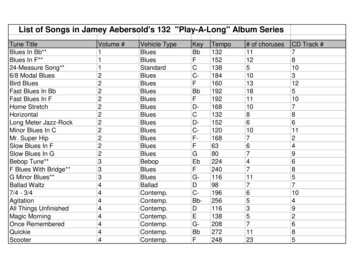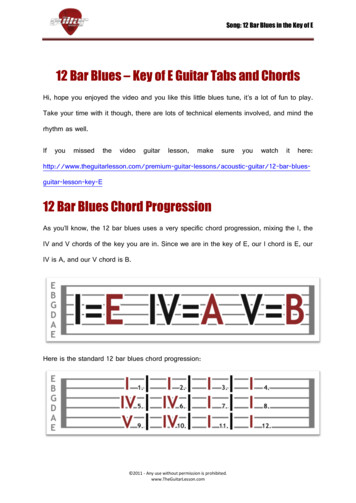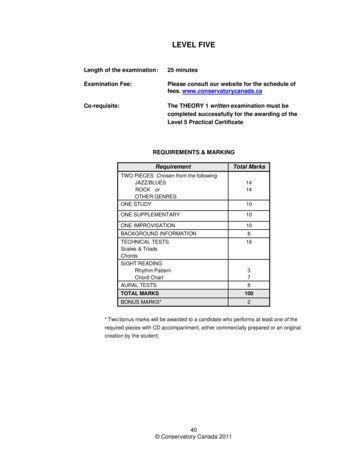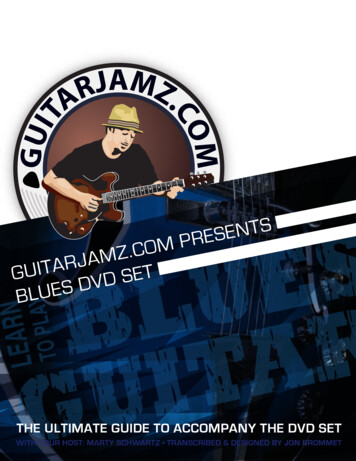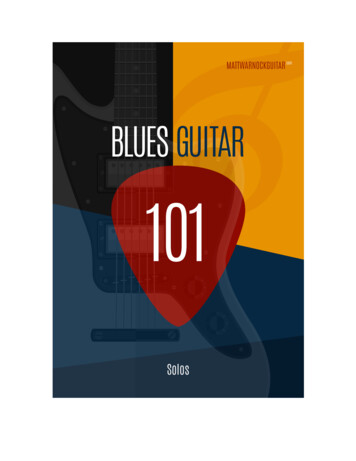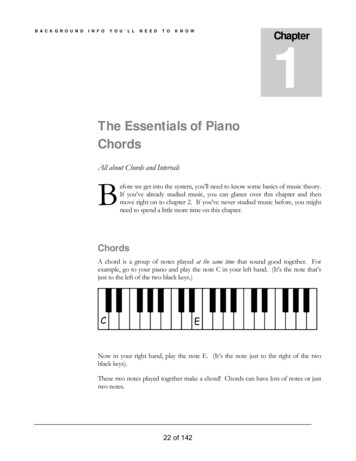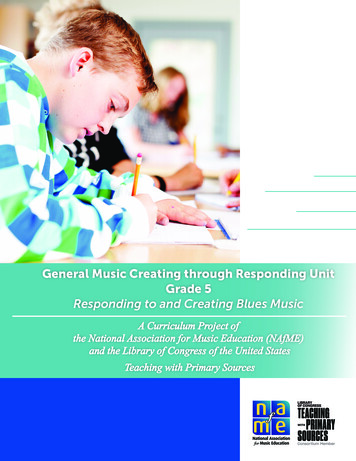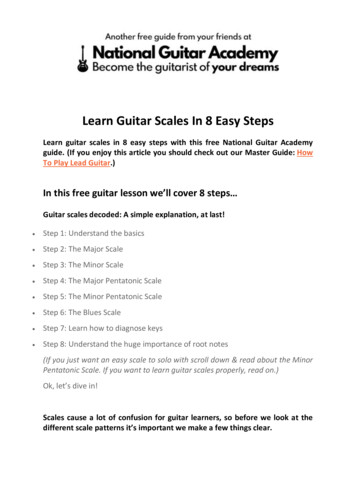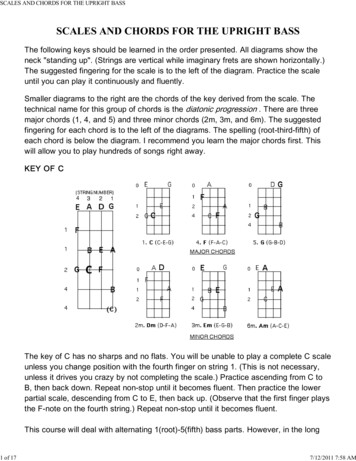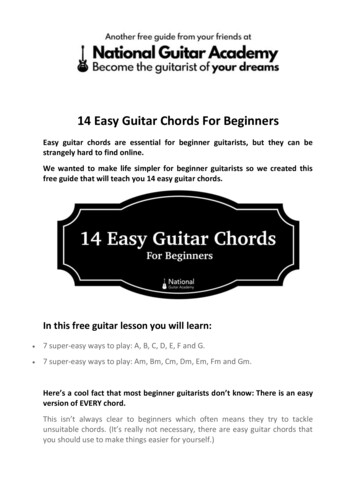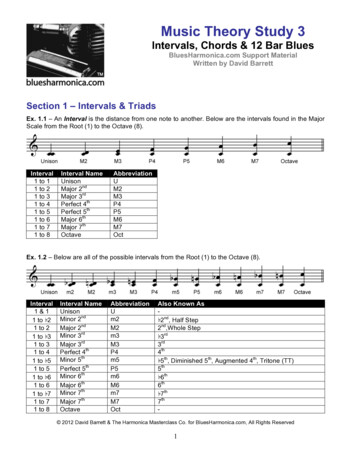
Transcription
Music Theory Study 3Intervals, Chords & 12 Bar BluesBluesHarmonica.com Support MaterialWritten by David BarrettSection 1 – Intervals & TriadsEx. 1.1 – An Interval is the distance from one note to another. Below are the intervals found in the MajorScale from the Root (1) to the Octave (8).Interval1 to 11 to 21 to 31 to 41 to 51 to 61 to 71 to 8Interval NameUnisonMajor 2ndMajor 3rdPerfect 4thPerfect 5thMajor 6thMajor 7thOctaveAbbreviationUM2M3P4P5M6M7OctEx. 1.2 – Below are all of the possible intervals from the Root (1) to the Octave (8).Interval1&11 to 21 to 21 to 31 to 31 to 41 to 51 to 51 to 61 to 61 to 71 to 71 to 8Interval NameUnisonMinor 2ndMajor 2ndMinor 3rdMajor 3rdPerfect 4thMinor 5thPerfect 5thMinor 6thMajor 6thMinor 7thMajor o Known As 2nd, Half Step2nd,Whole Step 3rd3rd4th 5th, Diminished 5th, Augmented 4th, Tritone (TT)5th 6th6th 7th7th- 2012 David Barrett & The Harmonica Masterclass Co. for BluesHarmonica.com, All Rights Reserved1
Ex. 1.3 – If you play the 1st note of the C Major Scale (C) then skip the 2nd note play the 3rd note(E) then skip the 4th note and finally play the 5th note (G) you create a Chord. C E G. In otherwords, three notes built in thirds. C to E is an interval of a 3rd and E to G is an interval of a 3rd—Thiscreates what’s known as a Triad.Ex. 1.4 – There are four types of chord qualities that can be built from a triad: Major, Minor, Diminishedand Augmented. Reminder: 3 half steps equals a Minor 3rd (m) interval and 4 half steps equals a Major3rd (M) interval.Chord QualityMajor Minor Diminished Augmented RootC C C C 3rdE E E E 5thG G G G IntervalM m m M m m M M RomanI i i o I Other FormsC (CM, CΔ, Cmaj or Cma) Cm, c (Cmin, Cmi or C-) Cdim (Cº or Cm( 5)) Caug (C or C( 5)) Ex. 1.5 – Exercise: Notate all of the chords built from the C Major Scale. Write the note names beloweach chord and above each chord write the chord quality in standard and Roman Numeral form. Thefirst two chords have been completed for you.Section 1 Questions1) What is the root note of the IV Chord?2) What is the 3rd of the Dm Chord?3) What is the 5th of the V Chord?4) What three chord qualities are found from the chords built on the Major Scale?For More Information1) Intervals, Wikipedia http://en.wikipedia.org/wiki/Intervals (music)2) Chord, Wikipedia http://en.wikipedia.org/wiki/Chord (music)2
Section 2 – 12 Bar Blues Progression & TriadsEx. 2.1 – Here is the same information you filled out for Example 1.5. Notice how the three major chordsare the I, IV and V Chords—these are the chords used for 12 Bar Blues.Ex. 2.2 – Notated below is the 12 Bar Blues Progression. This progression repeats until the song ends.Note that the terms Bar and Measure are used interchangeably (both equal the time of four beats). Alsonote that for the first four bars you only see the I chord shown in bar 1—you’ll stay on a given chord untilyou see another chord notated (in this case bar 5, the IV chord).Ex. 2.3 – Exercise: Fill in the chart below with pitches for the C Major Diatonic Harmonica with bends.3
Ex. 2.4 – It’s the job of the rhythm section (drums, bass, rhythm guitar, piano, etc.) to play the notes ofthe chord in an interesting way. By changing the rhythmic and harmonic (chord quality) presentation ofthe chords used in Blues, different Grooves are created (reference the lesson Performance Training:Groove).This example uses the same triad as in Example 2.2, but presents the notes in the Rhumba rhythm. Eventhough we’re not playing all of the notes at the same time (Simultaneity), they still construct the notes ofthe chord (Arpeggio). Playing the notes of a chord sequentially in time is called an Arpeggio. You canplay all three notes of a chord at one time or play two notes of the chord at one time (two notes areenough to infer a chord) or play them one at a time sequentially (in whichever order you wish) theend result is still the same a chord.Reminder: The I chord has a Root of C, 3rd of E and 5th of G. The IV chord states the Root is F. Whenwe’re speaking of the Key of C, C is the root—or home base—of the song. When we’re speaking ofchords, the bottom-most note of the chord is the Root of the chord. This is why for the IV chord it isnotated with a Root of F, 3rd of A and 5th of C. In turn, the V chord it is notated with a Root of G, 3rd of Band 5th of D. the intervals we’re speaking of are all relative to the chord you’re speaking of. The bestway of keeping this straight is to use the phrase “Scale Degree” for the scale (e.g., thee 1st Scale Degreeor 6th Scale Degree) and use the phrase “of the chord” for a notes position in the chord (e.g., the 3rd of theChord or 5th of the Chord). I have used these labels to this point, but wanted to make you aware of it.Question: If you’re using the C Harmonica to play Example 2.4, what position are you playing in?Ex. 2.5 – Exercise: Complete the information for this Rhumba in the Key of C. Follow the order ofcompletion below.1. Write the note names2. Write the degree of the chord3. Write the harmonica TAB for the lower octave of the harmonica (holes 1 to 4) and middle octave(4 to 7).4. Play the example in whichever octaves is easiest for you (the lower octave requires bending skill).4
Ex. 2.6 – Exercise: Complete the G Major Scale and Chords below. Circle the I, IV and V Chords.Ex. 2.7 – Exercise: Complete the information for this Rhumba in 2nd Position (Key of G) on a CHarmonica. Follow the order of completion below.1.2.3.4.Write the note namesWrite the degree of the chordWrite the harmonica TABPlay the example5
Ex. 2.8 – Exercise: Complete the D Major Scale and Chords below. Circle the I, IV and V Chords.Ex. 2.9 – Exercise: Complete the information for this Rhumba in 3rd Position (Key of D) on a CHarmonica. Follow the order of completion below.1.2.3.4.Write the note namesWrite the degree of the chordWrite the harmonica TABPlay the exampleSection 2 Questions1) What are the three chords commonly used in Blues (use Roman Numerals)?2) What does the term Arpeggio mean?3) What does the term groove mean?4) Why did we play examples in the keys of C, G and D on our C Harmonica?For More Information1) Twelve-bar Blues, Wikipedia http://en.wikipedia.org/wiki/Twelve-bar blues6
Section 3 – 12 Bar Blues Progression & 7th ChordsEx. 3.1 – To build a triad, we started on a Scale Degree and built in 3rds (essentially using every othernote from the root—the bottom most sounding note of the chord). If we add one more note to the triad weget what’s known as a Major 7th Chord (in other words, a triad with the presence of a note a 7th abovethe root). If we build a G chord, we get G as the Root, B as the 3rd, D as the 5th and F as the (Major) 7th.Let’s look at the Key of G for this example.Ex. 3.2 – There are four forms of the 7th chord quality that we commonly run across in a Major or Minorkey. These are shown below.Chord QualityMajor 7th Dominant 7th Minor 7th Half-Diminished 7th RootG G G G 3rdB B B B 5thD D D D 7thF F F F IntervalM m M M m m m M m m m M RomanIM7 I 7 i 7 iø7 Also Known AsGM7 (Gmaj7 OR GΔ7)G7 (Gdom7)Gm7 (Gmin7, g7 or G 7)Gm7 5 (Gø7 or G 7( 5))Ex. 3.3 – There are two forms of the 7th chord quality that we work with often for Blues harmonica. One isthe Major-Minor 7th Chord (also known as a Dominant 7th Chord, or simply 7th Chord), where we use aMajor Triad (the “Major” part of the name) with a Minor 3rd interval added on top (from the 5th to the 7th).The other is the Minor-Minor 7th Chord (Commonly known as just the Minor 7th Chord), where we use aMinor Triad (the “Minor” part of the name) with a Minor 3rd interval added on top (from the 5th to the 7th,just like the 7th Chord). The key element here is that the 5th to the 7th must be a Minor 7th interval—it’swhat gives the chord its signature Bluesy sound.Ex. 3.4 – We’ve already studied that the three most common chords used in Blues are the I, IV and VChords. When we add the 7th to these chords we get a much more bluesy sounding versions of these777chords I , IV and V . Below are these chords for the C Harmonica played in 2nd Position, key of G.7
Ex. 3.5 – Here’s another way to look at the notes of the three chords commonly used in 12 Bar Blues.Used again is the C Harmonica played in 2nd Position, Key of G. Chord I7 (G7)IV7 (C7)V7 (D7) Root G C D 3rd B E F 5th D G A 7th F B C Ex. 3.6 – Exercise: Fill in the chart below for the C Major Diatonic Harmonica with bends. Start by using a7colored pen or pencil and only filling in the notes of the I Chord (G7). Then use a different color to write77in the notes of the IV Chord (C7). And finally with a different color, fill in the notes of the V Chord (D7).Some notes will overlap—this is fine.Ex. 3.7 – Our example below is a common Blues bass line played on the harmonica. This bass line usesthe root, 5th and 7th of the chord. The omission of the Major 3rd gives this bass line a bluesy quality. Ihave written out the first measure for you. Complete the rest of the chorus.8
Ex. 3.8 – Exercise: Fill in the chart below. Chord I7 (G7)IV7 (C7)V7 (D7) Root 3rd 5th 7th Ex. 3.9 – Here’s another cool line, which uses the root and 7th. Complete the rest of the chorus.77Fact – To figure out how to play the original presented line on the IV and V Chords, you analyzed theI7 Chord to find out what chord tones were being used. You were in essence Transposing this lick to theother chords—this is called a Sequence.Section 3 Questions1) What are the three different names for the most common 7th Chord spelling used in Blues?2) What has the addition of the 7th for each Chord done to the sound of the progression?For More Information1) Sequence, Wikipedia http://en.wikipedia.org/wiki/Sequence (music)9
Section 4 – 12 Bar Blues Progression, One Hole at a TimeEx. 4.1 – Exercise: Fill in the chart below with pitches for the C Major Diatonic Harmonica with bends.Ex. 4.2 – Exercise: Fill in the chart below. Chord I7 (G7)IV7 (C7)V7 (D7) Root 3rd 5th 7th Ex. 4.3 – Using the information above, fill in the chart below with each note option for the given chord and7hole. Hole 1 has been completed for you. The I Chord is G B D F. On hole 1 of the harmonica the notes7are D (1 draw), D (1 draw bend) and C (1 blow) are available. 1 draw is D, the 5th of the I Chord, so I777placed “1” for 1 draw in the I Chord column. The IV Chord is C E G B . 1 blow is C, the Root of the IV77Chord, so I placed “1 ” for 1 blow in the IV Chord column. The V Chord is D F A C. 1 draw is D, the77Root of the V Chord, and 1 blow is C, the 7th of the V Chord, so I placed “1” for 1 draw and “1 ” for the71 blow in the V Chord column. Complete the rest of the chart, making sure to double-check your work. Hole I7 (G7)IV7 (C7)V7 (D7)111 1 / 1234510678910
Ex. 4.4 – Exercise: Hole 1This is your opportunity to REALY get to know your harmonica in the most common position played, 2ndPosition. This is REAL WORLD knowledge that you can apply—now that you’ve taken your medicine tounderstand the basics of scales and chord construction. Let’s learn the harmonica one hole at a time.Look carefully at the chart I have filled in for you below.The key to understanding music on the harmonica is in knowing whichhole you’re playing, what the pitch is and how it relates to the chord you’replaying over.The chart below shows those three pieces of information for the first hole of the harmonica. Hole 1I7 (G7)IV7 (C7)V7 (D7)TAB11 1 / 1PitchDCC/DDegree5thRoot (R) 7th / REx. 4.5 – Exercise: Let’s apply your knowledge of where you’re playing on the harmonica, what pitchesthey are and how they relate to the chords you’re playing over. Play the example below in the followingways, making sure to get enough reps in before moving on to the next exercise to master the concept.1. Play to the provided jam track and enjoy the sound quality that each note produces as you playover the chords in the 12 Bar Blues Progression. Add tremolo/vibrato, dynamics and any othertechniques to present these notes as musically as possible.2. Close your eyes now and play the example from memory. As you play, say in your mind the holenumber you’re playing (Ex., 1 draw, 1 blow, etc.).3. Still playing from memory, say in your mind the pitch you’re playing (Ex., D).4. Still playing from memory, say in your mind the Scale Degree that you’re playing (Ex., 5th, Root,3rd).5. Say items 2 through 4 as you play (Ex., 1 draw D is the 5th of the I chord / 1 blow C isthe Root note of the IV chord).11
Ex. 4.6 – Exercise: Hole 2 - Let's now do the same for the second hole on the harmonica. Fill in the chartbelow. Hole 2I7 (G7)IV7 (C7)V7 (D7)TABPitchScale DegreeNow play your second hole on the harmonica in the same rhythm as you played for Example 4.5 in thefollowing ways. Play each exercise as many times as it takes to master it before moving to the next itemon the list. Some holes have more than one option—experiment with the options. Say in your mind 1.2.3.4.The hole numbers as you playThe pitches as you playThe scale degrees as you playAll of aboveEx. 4.7 – Exercise: Hole 3TABPitch Hole 3Scale Degree7I (G7)IV7 (C7)V7 (D7)1.2.3.4.Say hole numbers as you playSay pitches as you playSay scale degrees as you playSay all of aboveEx. 4.8 – Exercise: Hole 4TABPitch Hole 4Scale Degree7I (G7)IV7 (C7)V7 (D7)1.2.3.4.Hole numbersPitchesScale degreesAll of above7Ex. 4.9 – Exercise: Hole 5 (you’ll find no options for the V —substitute another hole)TABPitchScale Degree Hole 5I7 (G7)IV7 (C7)V7 (D7)1.2.3.4.Hole numbersPitchesScale degreesAll of above12
Ex. 4.10 – Exercise: Hole 6TABPitch Hole 6Scale Degree7I (G7)IV7 (C7)V7 (D7)1.2.3.4.Hole numbersPitchesScale degreesAll of aboveEx. 4.11 – Exercise: Hole 7TABPitch Hole 7Scale Degree7I (G7)IV7 (C7)V7 (D7)1.2.3.4.Hole numbersPitchesScale degreesAll of aboveEx. 4.12 – Exercise: Hole 8TABPitch Hole 8Scale Degree7I (G7)IV7 (C7)V7 (D7)1.2.3.4.Hole numbersPitchesScale degreesAll of aboveEx. 4.13 – Exercise: Hole 9TABPitch Hole 9Scale Degree7I (G7)IV7 (C7)V7 (D7)1.2.3.4.Hole numbersPitchesScale degreesAll of aboveEx. 4.14 – Exercise: Hole 10TABPitch Hole 10Scale Degree7I (G7)IV7 (C7)V7 (D7)1.2.3.4.Hole numbersPitchesScale degreesAll of above13
Ex. 4.15 – Exercise: Fill in the chart below with pitches for the C Major Diatonic Harmonica with bends.Ex. 4.16 – Exercise: Fill in the chart below. Chord I7 (G7)IV7 (C7)V7 (D7) Root 3rd 5th 7th Ex. 4.17 – Exercise: Fill in the chart below with HOLE NUMBERS. Hole I7 (G7)IV7 (C7)V7 (D7)111 1 / 1234567891067891078910Ex. 4.18 – Exercise: Fill in the chart below with PITCHES. Hole I7 (G7)IV7 (C7)V7 (D7)1DCC/D2345Ex. 4.19 – Exercise: Fill in the chart below with SCALE DEGREES. Hole I7 (G7)IV7 (C7)V7 (D7)15thR2345 7th / R146
Section 4 Questions1) What’s a general statement you could say to a new harmonica player to help them match when7playing over the I ?2) What’s a general statement you could say to a new harmonica player to help them match when7playing over the IV ?73) What advice would you give a new player about how to play over the V ?4) Why are we only using a C Harmonica in this example?5) Would the note names if we change positions?Explain:15
Section 5 – Minor Blues ChordsEx. 5.1 – Exercise: Fill in the chart below with pitches for the C Major Diatonic Harmonica with bends.Ex. 5.2 – Exercise: Fill in the chart below. Chord I7 (G7)IV7 (C7)V7 (D7) Root 3rd 5th 7th In Theory Study 2 you learned that the Minor Scale uses a 3rd, 6th and 7th. In this study you learnedthat to turn a Major chord into a Minor chord all you had to do was lower the 3rd (C E G B turns into C E 77G B for example)—this needs to be done for the I and IV chords. In Minor Blues it’s common to have7the V remain Major, so you’ll want to notate both versions. Fill in the chart below reflecting the chordsused in Minor Blues.Ex. 5.3 – Exercise: Fill in the chart below. Chord i7 (Gm7)iv7 (Cm7)V7 (D7) or v7 (Dm7) Root ( )3rd 5th 7th Ex. 5.4 – Exercise: Fill in the chart below with HOLE NUMBERS for playing in minor. Hole i7 (Gm7)iv7 (Cm7)V7 (D7)111 1 / 12345678910Ex. 5.5 – Exercise: Play example 5.4 above one note at a time to the provided Minor Jam Track, just likeyou did for examples 4.5 through 4.14.16
Section 6 – Extended Chord TonesEx. 6.1 – To build a triad, we started on a Scale Degree and built in 3rds (essentially using every othernote from the root—the bottom most sounding note of the chord). We then added one more note to thetriad for the 7th Chord (in other words, a triad with the presence of a note a 7th above the root). If we addanother note a third above the 7th, we get the 9th—a note with a jazzy quality. The 9th Chord is mostcommonly presented with a 7th (a 9th added to a Major-Minor 7th Chord in a Major key or a 9th added to aMinor-Minor 7th Chord in a Minor key—in both spellings the 9th is the interval of a major third above the 7th).Ex. 6.2 – Here are our three chords with the addition of the 9th.Ex. 6.3 – Here are our three 9th Chords tabbed out on the harmonica. Note that when we play the notesof the chord one after another it’s called an Arpeggio.You can add the chord by continuing in thirds to create 11th Chords (the addition of the note “C” in thiscase) and 13th Chords (the addition of “E” in this case, after the 11th), with the 15th not existing due to thefact that the 15th is the Root. Though these chords present interesting voicing options for chordalinstruments (piano and guitar for example), where the color of a chord carries importance, we tend not tobenefit from the study of these chords in the Blues. For players wishing to become well verse in Jazz,further studies into these chords is justified.An interesting chord often used in the Blues is the Major 6th Chord. The Major 6th Chord is built from amajor triad (G B D for example) with the addition of a 6th from the Root (a whole step from the 5th). The 6thhas a Major quality to it, and is therefore most appropriately used in lighter Blues contexts, such as Jump& Swing Blues, Shuffles, Rhumbas, and other non-dark grooves. Note that the 6th can also be though ofas a 13th Chord, with the 13th voiced above the 5th.17
Ex. 6.4 – Here are our three 6th Chords.Ex. 6.5 – Here are our three 6th Chords tabbed out on the harmonica.Ex. 6.6 – Here’s our Major 6th Chords played as a common bass lineEx. 6.7 – Here’s the same bass line presented the way a professional player would play it—with slapsand pulls.18
Ex. 6.8 – The Rhumba rhythm uses the Major 6th Chord to very nice affect.Ex. 6.9 – Notice how the most famous Blues harmonica lick of all time uses the Major 6th Arpeggio(opening lick to Little Walter’s “Juke”).For More Information1) Extended Chords, Wikipedia http://en.wikipedia.org/wiki/Chord extension2) 6th Chord, Wikipedia http://en.wikipedia.org/wiki/Sixth chord19
Section 7 – Another Look at Harmonica ConstructionEx. 7.1 – In example 2.4 of Music Theory Study 1 you filled in the notes of the C Major Harmonica withthe notes of the C Major Scale. Do this again for example 7.1 below.Ex. 7.2 – In example 3.2 of Music Theory Study 1 you found out another way of looking at the notes ofthe Major Scale was to number them—known as Scale Degrees.Ex. 7.3 – You then replaced notes of the C Harmonica with Scale Degrees. Do that again here.Ex. 7.4 – Exercise: Let’s now use another way of looking at the harmonica—how it’s built with chords. Fillin the harmonica again with pitch names and analyze it relative to the Key of C.Ex. 7.5 – You saw that the notes “C E G” were found on the blow notes, creating a Root Position I Chord(Root Position means that the lowest sounding note of the chord is the Root). You found that the draw9side, from holes 2 through 9, were the notes “G B D F A,” which is a V Chord. Hole 1 draw is the 5th ofthe chord and holes 7 through 10 repeat the pitches of holes 3 through 7.20
Ex. 7.6 – Another way to analyze the draw chord is to think of holes 1 through 3 as the V Chord (D G B 5th R 3rd) and from 4 draw as the ii Chord (D F A R 3rd 5th), with the 7 draw being thought of as the 6th6of a ii Chord (D F A B R 3rd 5th 6th) or as the 3rd of the V Chord.Ex. 7.7 – It’s more accurate to look at the harmonica from the perspective of both the C Major Scale andChords. Holes 1 through 3 blow construct the I Chord (C E G R 3rd 5th) and draw construct the V Chord(D G B 5th R 3rd). Holes 4 and above create a complete C Major Scale, minus the B at the top, in thiscase to preserve the chord blocks. In the tuning of the harmonica—in all its varied systems—it’s atradeoff between chord and scale availability.Ex. 7.8 – Since we do most of our playing in 2nd Position it’s a good idea to look at the chords relative to2nd Position as well. 2012 David Barrett & The Harmonica Masterclass Co. for BluesHarmonica.com, All Rights Reserved21
Section 8 – Completed ExercisesEx. 1.5Ex. 2.3Ex. 2.522
Ex. 2.6Ex. 2.7Ex. 2.823
Ex. 2.9Ex. 3.624
Ex. 3.7Ex. 3.8 Chord I7 (G7)IV7 (C7)V7 (D7) Root GCD 3rd BEF 5th DGA 7th FB CEx. 3.925
Ex. 4.1Ex. 4.2 Chord I7 (G7)IV7 (C7)V7 (D7) Root GCDEx. 4.3 Hole I7 (G7)IV7 (C7)V7 (D7)111 1 / 1 3rd BE 5th DGAF 22” / 22 / 22’Ex. 4.6 – Exercise: Hole 2TABPitch Hole 272” / 2F/GI (G7)72 /2E/GIV (C7)72’V (D7)F 7th FB C33 / 33 / 3’3”444 4 / 4555 -Scale Degree 7th / R3rd / 5th3rdEx. 4.7 Hole 3I7 (G7)IV7 (C7)V7 (D7)TAB3 / 33 / 3’3”PitchG/BScale DegreeR / 3rdG / B A5th / 7th5thEx. 4.8 Hole 4I7 (G7)IV7 (C7)V7 (D7)TAB44 4 / 4PitchDCC/DScale Degree5thREx. 4.9 Hole 5I7 (G7)TAB5PitchFScale Degree5 E7IV (C7) 7th / R 7th3rd2666 6 6777 7 888 899 / 9 9 9’ 1010’ 10” / 10 10 / 10
Ex. 4.10 Hole 6I7 (G7)IV7 (C7)V7 (D7)TAB6 6 6PitchGGAScale DegreeR5th5thEx. 4.11 Hole 7I7 (G7)IV7 (C7)V7 (D7)TAB77 7 PitchBCCScale Degree3rdREx. 4.12 Hole 8I7 (G7)IV7 (C7)V7 (D7)TAB88 8PitchDEDScale Degree5th3rdREx. 4.13 Hole 9I7 (G7)IV7 (C7)V7 (D7)TAB9 / 9 9 9’ PitchF/GGScale DegreeF Ex. 4.14 – Exercise: Hole 10TABPitch Hole 10710’ BI (G7)710” /10 IV (C7)B / C710/10 A/CV (D7) 7th 7th / R5th3rdScale Degree3rd 7th / R5th / 7thEx. 4.1527
Ex. 4.16 Chord I7 (G7)IV7 (C7)V7 (D7) Root GCDEx. 4.17 Hole I7 (G7)IV7 (C7)V7 (D7)111 1 / 122” / 22 / 22’33 / 33 / 3’3”444 4 / 4555 -Ex. 4.18 Hole I7 (G7)IV7 (C7)V7 (D7)1DCC/D2F/GE/G3G/B4DCC/D5FE-Ex. 4.19 Hole I7 (G7)IV7 (C7)V7 (D7)15thR 7 / Rth 3rd BEF 5th DGA 7th FB CF G / B A23 7 / R3rd / 5th3rdth3rdR/5th / 7th5th55th 73rd-thR 7 / Rth Root GCD 3rd BEF 5th DGA 7th FB C28777 7 888 86GGA4Ex. 5.1Ex. 5.2 Chord I7 (G7)IV7 (C7)V7 (D7)66 6 66R5th5th99 / 9 9 9’ 7BCC8DED9F/GGF 1010’ 10” / 10 10 / 10 10BB / CA/C789103rd5thR3R 7 / R5th3rd3rd 7th / R5th / 7th 7thrdth
Ex. 5.3 Chord i7 (Gm7)iv7 (Cm7)V7 (D7) or v7 (Dm7)Ex. 5.4 Hole i7 (Gm7)iv7 (Cm7)V7 (D7)111 1 / 1 Root ( )3rd GB CE DF / F22” / 222’33 / 3’3 / 3’3” 5th DGA 7th FB C444 4 / 455-66 6 677 7 888’ 899 / 9 9 9’ 1010” 10” / 10 10 / 10 Ex. 7.1Ex. 7.3 2012 David Barrett & The Harmonica Masterclass Co. for BluesHarmonica.com, All Rights Reserved29
3 Section 2 – 12 Bar Blues Progression & Triads Ex. 2.1 – Here is the same information you filled out for Example 1.5. Notice how the three major chords are the I, IV and V Chords—these are the chords used for 12 Bar Blues. Ex. 2.2 – Notated below is the 12 Bar Blues
